
Sep '08 - Feb '09
It's been a busy month for me. Live projects coming to a close (see previous entry), conferences and the start of our studio has left me with little to no time to get anything done (well, apart from having the odd beer or six at various functions). I've decided to break this one down into five sections. Apparently, we're not supposed to be plugging a bunch of links, but believe me, the student body has been very very productive over the last month. Following on from my ramblings on the direction of the school's website, with progress being relatively slow, a bit of a counter-culture led by the students has sprung up over the web, with research networks or other interesting projects beginning to surface. I wonder what the official reaction from the School will be, but in any case, our burgeoning online presence is beginning to show a flavour of the kinds of things we get up to.
AGENCY Conference
The Agency conference is an AHRA international architectural conference. This year, it was held at the University of Sheffield. In their own words,
"AGENCY accepts that the conditions for effective action are both contingent on individual circumstances and constantly changing. Nevertheless, the conference sets out to explore how humanities research can better contribute towards understanding current architectural needs, possibilities and capacities for action. It will explore what is meant by ‘action’ in this context, what kinds of activities and conditions are relevant, what prevents the effective exercise of agency, and how the consideration of such prevention might indicate effective points of, and tactics for, alternative action." (source: http://www.agency-conference.info)
Despite having to organise logistics, I managed to attend a few of the talks. Following the amazing seminar session with Jon Goodbun (http://www.wag-architecture.co.uk), the general theme of the seminar and indeed, the discussion of designing architecture as a series of systems within a framework of environmental, social and psychological ecologies (see Guattari - as opposed to the strict fetishisation of building as object) was a refreshing re-affirmation of my developing interest of seeing the architects role as a facilitator, or an agent of positive change. 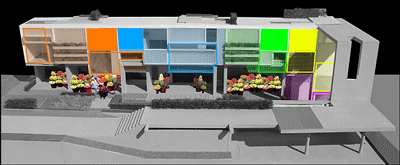
Cruz's high density micro-project on the San Diego/Tihuana border. Source: NY Times
Teddy Cruz's (http://www.nytimes.com/2008/02/19/arts/design/19hous.html) keynote was an impressive catalogue of projects working within the existing tension between the 'McMansions' of San Diego, and their innovative relocation and inhabitation by the inhabitants of Tihuana, south of the border. "It's not just about designing the programmatic space", to paraphrase Cruz, "we also have to design the localised political framework to allow density (density as a measure of micro-economy and social capital, rather than persons per area) to occur".![]()
Source: Infranet Labs.
The last talk I attended was presented by Archinect contributor Mason White, whose Infranet Lab (http://infranetlab.org/blog) was a fantastic insight into emerging practice mechanisms for architects, and again, a re-affirmation of my own interests.
The conference dinner was quite simply awesome. I'm sure there are some photos floating around, but suffice to say, the 1st year studio was transformed into a rather nice candle lit series of clusters (only possible through some quick thinking and a cab down to Tesco for candles and lighters), and the most amazing curry for all the delegates and whichever students turned up. The free beer and wine flowed well too, culminating in the hardcore boozers dancing on the tables by the end of the night..
Sheffield Food Network
So the Food Network website has finally gone live, you can see it at http://www.sheffieldfoodnetwork.org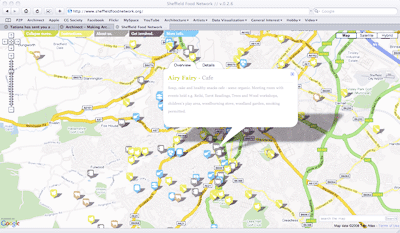
Screenshot of the live website. Completely reprogrammed from scratch.
For those who haven't read my previous blog posts, the SFN is a the output of a student run Live Project, which is a 6 week real project, with a real client, with a real budget (or no budget in our case) held at the beginning of every academic year at the School of Architecture. A group of 11 worked with local food growers and other organisations to map sustainable food sources in Sheffield, using a reprogrammed Google Map as an intuitive interface. This may seem very 'unarchitectural' but designing the entire system, including public consultation, events, collation of research, synthesis etc. stretched our skills as a group. The client-student dynamic was very good for this project, having acquired the client during the summer. As the name suggests, the whole network was justified when Grow Sheffield, the client met with Food Aware - an organisation who distributes food products that are perfectly edible but fail a visual inspection or something similar and cannot go to supermarkets (most of the food is currently landfilled).
Given the project had zero budget (we ended up spending £30 on hosting), I think we did a pretty good job. The idea and interface are simple to use (we have some minor things to iron out), with management of the system being done through a Google spreadsheet. Parameters are filled out and the icon is automatically generated onto the map. So therefore client management of the system is easy to use. We're hoping to iron out some technical issues quickly and start getting some serious coverage by the media. Watch this space.
Studio 2 Tactics
Following (very) swiftly on from the Live Project comes the studio. Having essentially engineered my studio choice this year, I was pleased to find out I was in my first choice (unlike other schools, there is no interview process). The theme of the studio is tactics, from the point of view of peer to peer networking. A much more detailed description can be found on the 'About' section of the Ning network (link below). 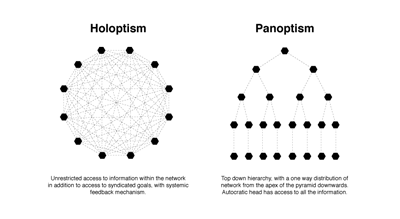
Using peer to peer as a starting point, individual threads of exploration will follow. Currently, the group has engaged in a number of research exercises that focus on creating a vocabulary of keywords that look at network society and their implications, so keywords such as 'open source' sits next to 'holoptism' and Guattarri's Three Ecologies. Eagle eyed readers will pick up the fact that some of the AGENCY talks were very relevant to the studio discussions.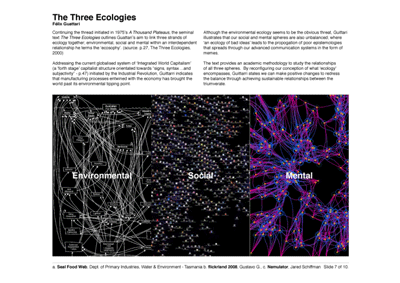
This week, we are establishing the complex interdependent relationships between these concepts, with complex diagrams emerging showing these connections. Having managed to download Dia, a UML diagram generator, the intention is to map complex relationships in a relatively stripped down visual language. In the spirit of peer to peer networking, we have also initiated a LETS (Local Economy Trading Scheme), where goods and skills are exchanged without monetary exchange. I am personally interested into whether this turns into a gift culture (see Eric S. Raymond, Homesteading the Noosphere) or does it become more formalised in a capital based economy.
One of the best things to come out of the studio in the spirit of our research is the fact we are employing social softwares to do it. Whereas last year, there were group blogs and wiki's floating around, this year we have gone for a more integrated approach, something I strongly indicate for the future of the School's website (see previous posts on my dissertation). This year several studios have opted to create a Ning network - it's essentially a specialised Facebook for small groups. Each member gets their own page, and can add images, blog entries and videos. The advantage being that member updates get posted to the main page, so the public can see what kind of things the studio is up to that is updated constantly. 
The studio's Ning network.
To view the Studio's Ning Network, go to http://studio2tactics.ning.com
Lunchtime Specials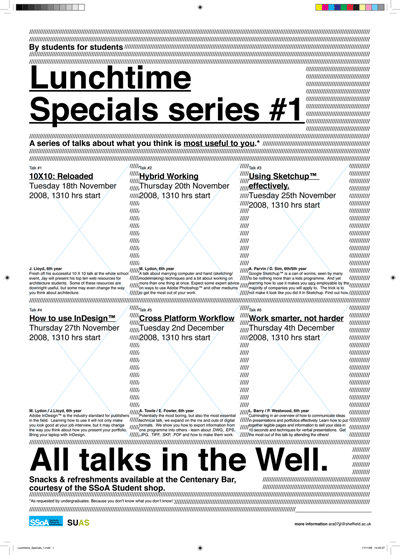
Lunchtime Specials are a series of talks given by architecture students for other architecture students. Unlike timetabled seminars, the talks focus on specific issues to expose students to a wide range of techniques that can improve their workflow or provide inspiration for their projects. The actual topics were chosen by undergraduate students themselves, with the postgraduate body initiating the first series. The series was literally organised in about 20 minutes, with the student and staff turnout at the first talk (given by me) weighing in at about 120 people.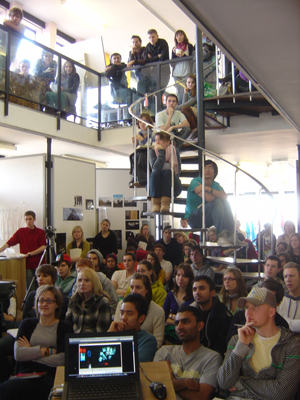
To watch the talk and find out more, please visit http://lunchtimespecials.blogspot.com
Thisbuildingleaks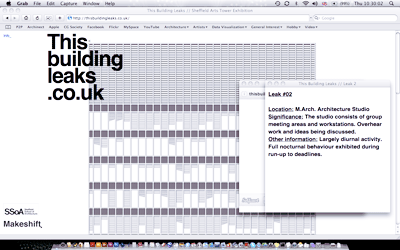
As part of the whole school event which happened about two weeks ago (the WSE is an annual series of workshops and talks with the aim of mixing up the year groups), two friends of mine proposed a 'live' exhibition of things happening inside the Arts Tower, where our studios are located. Parts of the studios are bugged, with more microphones and webcams being added over time - conversations and web feeds are being streamed in real time, navigable through the (very impressive) interface on the website, which is a facade of the Arts Tower generated entirely as html tables and columns (it took Adam a lllooooonnngggg time to code that one up).
To tune in, please visit http://thisbuildingleaks.co.uk
Makeshift
Another project by the duo who brought you thisbuildingleaks, this experimental fanzine was launched a little while ago and is beginning to get off the ground. 
The idea is that when you hit 'print', a PDF off the first ten articles are generated as a sample number, rather than a month. The PDF technology still needs work but it's a great idea. Contributions are welcome, feel free to mail the editors! http://www.bemakeshift.co.uk
'Til next time! Jay
2 Comments
For some reason the links take you back to the same page. I'm afraid you'll have to copy and paste the links, as I can't seem to edit the post.
- Jay
Great summary... and fantastic to read what you are up to.
I was very impressed with your school on my visit.
Block this user
Are you sure you want to block this user and hide all related comments throughout the site?
Archinect
This is your first comment on Archinect. Your comment will be visible once approved.